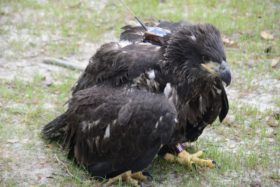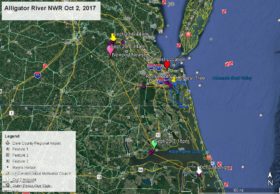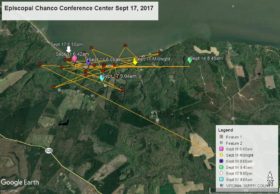Big Chick #1
Calm, Cool, Cloudy and Close
March 28, 2011Azalea in Chowan County, NC
March 29, 2011This evening March 28 just before dusk, the male adult brought in a large Gizzard Shad for dinner. Chick #1 walked out of what is left of the nest cup that has become flattened. Look how big (she – a guess) is now. In photo 4 and 5 look at (her) feet and how much they have grown. You can also see at 2 weeks and 1 day of age how (her) second coat has grown in. Weight now about one pound.
Also check the DGIF blog – http://eaglecam.tumblr.com/ and NBG videos – http://www.norfolkbotanicalgarden.org/e-community/eagle-cam/eagle-cam-videos for details of the duck meals delivered to the nest yesterday.









9 Comments
They sure do grow quickly!!! We see this every year but it’s still amazing to watch! Thanks, Reese.
Got on the website this morning, 3/29, and swear all 3 of the eaglets have grown since yesterday evening!! Thanks Reese for everything you do. I used photo #3 from the Calm, Cool….blog for my destop, too – love it!!!
I watched that feeding last night as well. I also loved the special time she had feeding eaglets 2 and 3. Very endearing.
Our babies are growing up too fast! Walking already! Its amazing how fast these little birds are learning to move out of the nest bowl.
Second photo from the bottom… check out the size of this eaglet’s feet! An indication of how big this bird will get!!
This is my first year to experience this. I’ve only been watching, thanks to a friends, since the 27th and they look doubled in size.
This is so wonderful to have to watch.
THANK YOU to all of you!!!
I have been watching sence the first Eaglet was hatched. Then the second one. I’m sorry to say I did not get to see the third one born. I’ve not had the chance to see them as much as I would love to see them as I’m in AZ. and most of the time by 5:00 P.M. It’s dark in your part .I’ve gone on Last night and to my surprise I was so taken back at how big they have gotten WOW!just amazing. I read the articles on how the Parents brought sea gull. never even would of emagined they would even eat that. I would just like to thank you and your staff for such a beautiful and exciting Experince. God Bless you all. Katie Lemme
All I have to say is have you ever seen the movie Happy Feet. LOL there adorable. Love, Love, and Love them all. Thank you Katie
Love this site. Keep up the awesome work.